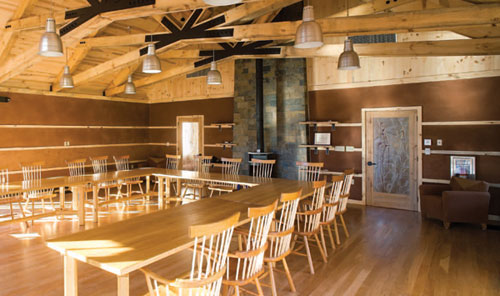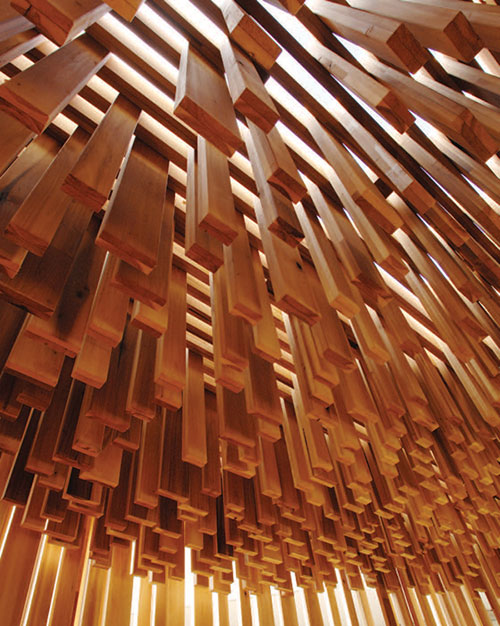The American Hardwood Advantage: Carbon-neutral Materials for Today's Zero Tolerance Goals
What is Carbon Neutrality?
Carbon neutrality is a voluntary mechanism that picks up where legislation leaves off, as entities from homes to air travel to public events are not adequately addressed by global climate policies, such as the Kyoto Protocol. While the idea of corporate carbon neutrality dates back to the mid-1990s, it wasn't until relatively recently that a critical mass of companies began making high-profile commitments to carbon neutrality.
Being carbon neutral refers to generating neutral, meaning zero, total carbon emissions - or that any carbon a facility does emit is counteracted or offset by positive environmental actions. In order to go carbon neutral, an organization must first take an inventory of the emissions it generates, and then reduce these emissions to the extent possible, purchasing "carbon offsets" to counteract any remaining emissions, with the ultimate goal being net zero emissions.
Generally, direct emissions sources must be reduced and offset completely, while indirect emissions from purchased electricity can be reduced with renewable energy purchases or other carbon offsetting strategies. Direct emissions include all pollution from manufacturing, company-owned vehicles, and reimbursed travel, livestock and any other source that is directly controlled by the owner. Indirect emissions include all emissions that result from the use or purchase of a product.
An organization may offset its carbon emissions by paying a third party to remove the carbon dioxide emitted from the atmosphere by planting trees or funding carbon projects that ideally lead to minimizing future greenhouse gas emissions; reasoning suggests that because greenhouse gases have a global impact, an investment to reduce emissions elsewhere - even halfway around the world - has the same climate benefit as if it were made locally. Carbon offsets are typically measured in tons of carbon dioxide equivalents and are bought and sold through international brokers, retailers and trading platforms.
Though many activities can generate carbon offsets, they generally fall into three main types:
- Renewable energy projects, including wind farms, or installations of solar, small hydro, geothermal, and biomass energy.
- Energy-efficiency projects, such as cogeneration and methane capture from landfills or livestock.
- Reforestation projects or other types of agriculture that sequester carbon dioxide from the atmosphere in the form of woody biomass. There are four general means by which agricultural and forestry practices can reduce greenhouse gases.
First, emissions can be avoided by maintaining existing carbon storage in trees and soils. Carbon storage can be increased by tree planting. Greenhouse gases can also be decreased by converting from conventional to conservation tillage practices on agricultural lands, and by substituting bio-based fuels and products for fossil fuels, such as coal and oil, and energy-intensive products that generate greater quantities of carbon dioxide.
According to carbonfund.org, "Of the three main types of offsets (renewable energy, energy efficiency and reforestation), reforestation is the only one that actually removes carbon dioxide from the atmosphere and puts it somewhere else, i.e., into the mass of a live growing forest. Also, scientists know that deforestation is responsible for about 25 percent of climate change, making reforestation a vital part of reducing emissions, while providing time to transition to a clean energy economy."
 |
The meeting room at Aldo Leopold Center, a LEED-platinum, carbon-neutral building, features cherry and oak flooring and red maple and cherry chairs. Photo courtesy of David Stluka© |
Â
Carbon neutrality is not without its critics, however. Opponents may argue that by purchasing carbon offsets, organizations and businesses are doing little more than buying their way out of doing their part in curbing global warming. Some dismiss carbon neutrality, decrying the promises made by carbon offsets as hollow claims and that solar panels and the like, while positive environmental steps, cannot put carbon from petroleum, natural gas and coal back into the earth.
On the flip side, realistically, it is difficult for an organization or business to eliminate all of its emissions. The move to carbon neutrality does offer green-minded entities an opportunity to reduce their environmental footprint and begin to generate a positive global climate impact. It is a matter of changing behavior - developing an emissions inventory can help an organization pinpoint the extent of its environmental impact, which can ultimately lead to emission reductions.
Carbon Neutrality and Design
The building sector accounts for nearly half of all annual greenhouse gas emissions in the United States. Over the next 25 years, carbon dioxide emissions in the building sector are projected to grow faster than any other sector, with emissions from commercial buildings estimated to have the fastest growth rate - 1.8 percent a year through 2030. In view of the situation, the move is on to design carbon neutral buildings that use substantially less energy, reduce greenhouse gas emissions and create spaces that are healthy and comfortable - all at market rates.
The U.S. Green Building Council (USGBC) awards Leadership in Energy and Environmental Design (LEED) points for sustainable buildings. According to the USGBC, the average LEED® certified building uses 32 percent less electricity and saves 350 metric tons of carbon dioxide emissions annually - a promising start. And LEED "Innovation in Design" points are now being awarded when building products and materials are certified as "carbon neutral" by a reputable, independent third party. Products and materials are climate-neutral when there are net zero greenhouse gases, such as carbon dioxide, from the entire life cycle of the product.
In May 2007, the USGBC joined with the American Institute of Architects (AIA), the American Society of Heating, Refrigerating and Air-Conditioning Engineers (ASHRAE), Architecture 2030, and the Illuminating Engineering Society of North America (IESNA) to finalize a memorandum of understanding that encourages the design of net-zero energy buildings, with the ultimate goal of carbon-neutral buildings by 2030. Carbon-neutral buildings use no energy from external power grids and can be built and operated at fair market values. To reach the energy reduction goal, the organizations agreed to define the baseline starting point for their common target goals as the national average energy consumption of existing U.S. commercial buildings, as reported by the 2003 Commercial Building Energy Consumption Survey (CBECS). This data is a set of whole-building energy use measurements gathered by the DOE's Energy Information Administration, which can be used to determine a national energy use intensity using kBtu/sqft-yr as the metric.
 |
Adjaye's Pavilion utilizes the American hardwood known as tulipwood. Photo courtesy of American Hardwood Export Council |
Â
In October 2007, the USGBC named its first-ever LEED-platinum, carbon-neutral building. The 13,000-square-foot Aldo Leopold Legacy Center is located in Baraboo, Wisconsin, on 80 acres of "worn-out farmland." The net-zero energy building, which produces over 110 percent of its annual energy needs, was designed by Kubala Washatko Architects, Inc., of Cedarburg, Wisconsin. The center makes substantial use of hardwood: its columns and beams were harvested from native trees that the Leopold family planted to improve their land, and a sustainable forest on the center grounds made a substantial contribution to the structure's carbon neutrality analysis.
Hardwood's contribution to a structure's carbon neutrality and environmental soundness is a decided plus. However, designers have a long history of specifying woods for their warmth, beauty and their striking aesthetics; now architects are showcasing hardwood in unconventional situations. American tulipwood appeared in a dramatic international application. David Adjaye, one of the United Kingdom's leading architects, created a pavilion at London's Southbank Centre as part of London Design Festival 2008's Size and Matter initiative. The 8-meter by 5-meter elliptical structure is formed of two circular chambers made of American tulipwood. Visitors first entered the smaller chamber and then passed into a wider space with a view of the London Eye. Adjaye selected American tulipwood for its inherent flexibility, strength, attractive grain and varying hues of pale yellow through mid brown. Although tulipwood's working properties make it suitable for a wide range of uses, it has not generally been specified for external applications or such large scale projects.
Adjaye wanted the tulipwood to be used in its natural state and allowed to age and go grey over time with exposure to light. In order to achieve this, American Hardwood Export Council found a new treatment process using hot oil (natural vegetable oil), involving a vacuum pressure process. This two-part hot-oil treatment process, developed by Osmose in the UK, is a brand new environmental technology. All the tests confirmed that the tulipwood can be treated and will be suitable for exterior use. Further testing is under way to ensure the production suitability of the use of treated tulipwood for external cladding and other outdoor applications.









